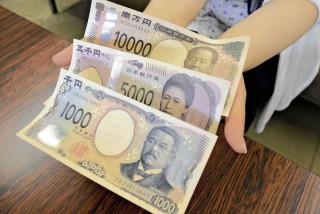Loading
Search
▼ New Banknotes Account for Only 30% of All Bills in Circulation; Increased Use of Cashless Payments Seen as Cause of Slow Adoption Rate
- Category:Other
Japan’s newest issued banknotes marked their first anniversary on Thursday, yet the new bills still only account for about 30% of all bills in circulation.
Although more vending machines and other devices have become compatible with the new bills, the replacement of older banknotes has been slow.
According to the Japan Vending System Manufacturers Association, nearly all railway ticket machines have become compatible with the new bills over the past year. The new bills are also being accepted by 50%-60% of beverage vending machines.
However, the transition is slow when compared to the last time new banknotes were introduced in 2004.
According to the Bank of Japan, the new bills introduced in 2004 made up 61.1% of those in circulation 11 months after their introduction. This time, however, the figure was only 28.8%.
This difference can be attributed to the increased use of cashless payment methods, such as credit cards and QR code transactions. The percentage of cashless payments rose to 42.8% in 2024, which is a 2.5-fold increase from 10 years ago. This reflects the growing number of people who do not use banknotes.
Another factor contributing to the slow adoption of the new banknotes is the increase in the number of people keeping cash at home. The number of bills in circulation grew from about 11 billion at the end of 2004 to about 17 billion at the end of 2024.
Banks have kept interest rates on deposits low due to the BOJ’s low interest rate policy. This has apparently prompted an increasing number of people to store cash at home, resulting in a fewer number of damaged or soiled older banknotes being returned to the central bank.
The city of Fukaya, Saitama Prefecture, the hometown of Eiichi Shibusawa, who is featured on the new ¥10,000 banknote, held an event on Wednesday to celebrate the first anniversary of the new bill’s issuance.
The stalls set up at the event attracted many visitors. Among those who were paying with the new banknotes, some were making payments using QR codes.
“I usually pay with my credit card or via QR code because I don’t want to bring bulky coins,” said a 50-year-old residet in the city.
However, experts believe that the demand for banknotes will remain to some degree. While cashless payments are convenient, they could become unusable in the event of a system malfunction or disaster. The new banknotes feature cutting-edge anti-counterfeit measures, which gives people more confidence in the bills.
“People will have fewer occasions to use cash, but it will continue to be a part of society,” said Tsuyoshi Ueno, a senior economist at the NLI Research Institute.
Although more vending machines and other devices have become compatible with the new bills, the replacement of older banknotes has been slow.
According to the Japan Vending System Manufacturers Association, nearly all railway ticket machines have become compatible with the new bills over the past year. The new bills are also being accepted by 50%-60% of beverage vending machines.
However, the transition is slow when compared to the last time new banknotes were introduced in 2004.
According to the Bank of Japan, the new bills introduced in 2004 made up 61.1% of those in circulation 11 months after their introduction. This time, however, the figure was only 28.8%.
This difference can be attributed to the increased use of cashless payment methods, such as credit cards and QR code transactions. The percentage of cashless payments rose to 42.8% in 2024, which is a 2.5-fold increase from 10 years ago. This reflects the growing number of people who do not use banknotes.
Another factor contributing to the slow adoption of the new banknotes is the increase in the number of people keeping cash at home. The number of bills in circulation grew from about 11 billion at the end of 2004 to about 17 billion at the end of 2024.
Banks have kept interest rates on deposits low due to the BOJ’s low interest rate policy. This has apparently prompted an increasing number of people to store cash at home, resulting in a fewer number of damaged or soiled older banknotes being returned to the central bank.
The city of Fukaya, Saitama Prefecture, the hometown of Eiichi Shibusawa, who is featured on the new ¥10,000 banknote, held an event on Wednesday to celebrate the first anniversary of the new bill’s issuance.
The stalls set up at the event attracted many visitors. Among those who were paying with the new banknotes, some were making payments using QR codes.
“I usually pay with my credit card or via QR code because I don’t want to bring bulky coins,” said a 50-year-old residet in the city.
However, experts believe that the demand for banknotes will remain to some degree. While cashless payments are convenient, they could become unusable in the event of a system malfunction or disaster. The new banknotes feature cutting-edge anti-counterfeit measures, which gives people more confidence in the bills.
“People will have fewer occasions to use cash, but it will continue to be a part of society,” said Tsuyoshi Ueno, a senior economist at the NLI Research Institute.
- July 3, 2025
- Comment (1)
- Trackback(0)



qlnz8- July 7, 2025